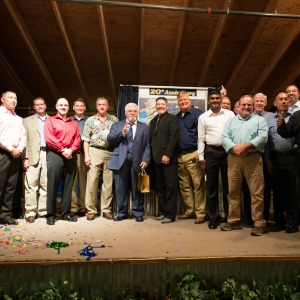Texas, Singapore military celebrate 20-year partnership
Story by: Capt. Jessica Jackson
Posted: Sept. 6, 2016
 Members of the inaugural Peace Prairie partnership participate in a photo during the 20-year celebration of the working relationship, Aug. 16, 2016, in Flower Mound, Texas.
Members of the inaugural Peace Prairie partnership participate in a photo during the 20-year celebration of the working relationship, Aug. 16, 2016, in Flower Mound, Texas.
The Peace Prairie partnership includes the Republic of Singapore Air Force and Texas National Guard. Pilots and crewmen from the Singapore military live and train in Texas to become proficient pilots before returning home. (U.S. Army National Guard photo by Capt. Jessica Jackson)
AUSTIN, Texas – Dozens of Singaporean airmen along with their Texas military counterparts gathered to celebrate a partnership that started 20 years ago, during a ceremony at Circle Ranch in Flower Mound, Aug. 16, 2016.
After the Singapore military did a commercial buy on Chinooks, the next step was to get their pilots the best training available. Leading them to the Texas National Guard.
Once their initial meeting with the Texas National Guard concluded, the Singaporeans were encouraged to research other state programs, looking at Mississippi’s, Pennsylvania’s and Nevada’s National Guards.
“I told them, go look at those states and when they were done looking, to get back to Texas and get ready to work,” said retired Lt. Col. Craig Rushing, the first U.S. Army Flight Training Detachment commander.
This was the birth of the Peace Prairie partnership. “And here it is 20 years later,” Rushing said.
With varying levels of flight experience, partnering with the guard provided both fictional and real-world training for pilots.
"Being part of the Guard, the RSAF was able to ramp up our Chinook capability as we participate in exercises like JRTC and Red Flag," said Lt. Col. Howe Siong Sen, Republic of Singapore Air Force Peace Prairie Detachment commander.
In addition to those exercises, the nature of Texas also provided unique training opportunities.
“Here in Texas we have to deal with fires and hurricanes, so we got them trained up on all those kinds of things — Army stuff,” Rushing said. “They knew about flying, but they didn’t know about being in the field or facing large-scale emergencies — they were tougher than I thought and I had some of the best to work with.”
When the Singaporean crewmen begin their training in the U.S., one of their first stops was with Master Sgt. Derek Smith, senior flight engineer instructor.
“We took what they learned in Singapore and expanded on it,” Smith said.
Newly assigned airmen to the Peace Prairie Detachment must go through three phases of training while here in the U.S., which can take up to six months.
“There’s a 90-day window between the different phases, but it’s all proficiency based,” Smith said.
Adding to the knowledge the pilots bring to the partnership, Texas Guardsmen ensure their Singaporean counterparts are aware of and abide by U.S. Army and Federal Aviation Administration regulations while flying in country.
This partnership does more than help develop confident pilots and aircraft engineers, it allows those involved to learn and grow, providing a rare opportunity for the airmen.
“It opens up the relationship base; there aren’t a whole lot of units that get to work hand-in-hand with a foreign military outside of a deployment,” Smith said. “They’re different on how they do things; we come together, meet in the middle and there’s some give and take.”
The Peace Prairie partnership has made strides to help continue positive relations between the two countries.
“The close ties we’ve built over the last 20 years, post operations, is very important,” said Sen.